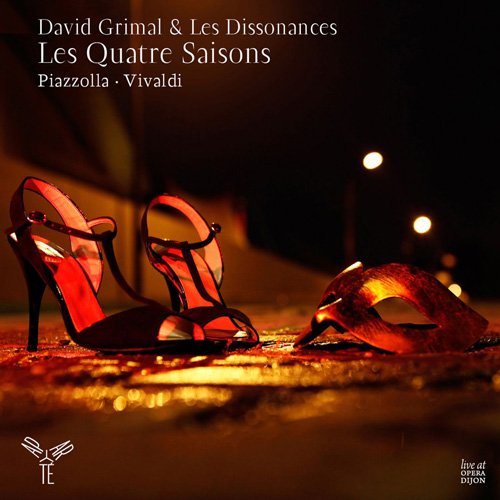David Grimal & Les Dissonances - Les Quatre Saisons: Piazzolla • Vivaldi (2010)

Artist: David Grimal, Les Dissonances
Title: Les Quatre Saisons: Piazzolla • Vivaldi
Year Of Release: 2010
Label: Aparte
Genre: Classical
Quality: FLAC (image + .cue, log, scans)
Total Time: 67:04 min
Total Size: 350 MB
WebSite: Album Preview
Tracklist:Title: Les Quatre Saisons: Piazzolla • Vivaldi
Year Of Release: 2010
Label: Aparte
Genre: Classical
Quality: FLAC (image + .cue, log, scans)
Total Time: 67:04 min
Total Size: 350 MB
WebSite: Album Preview
Antonio Vivaldi (1678-1741)
[1]-[3] La Primavera
Astor Piazzolla (1921-1992)
[4] Verano porteño
Antonio Vivaldi
[5]-[7] L'Estate
Astor Piazzolla
[8] Otoño porteño
Antonio Vivaldi
[9]-[11] L'Autunno
Astor Piazzolla
[12] Invierno porteño
Antonio Vivaldi
[13]-[15] L'Inverno
Astor Piazzolla
[16] Primavera porteño
This recording by French violinist David Grimal and the chamber orchestra Les Dissonances has a specific goal in mind: proceeds from its sale benefit the homeless through microcredit projects, and the group has performed live concerts for homeless audiences on the street. This unique enterprise should give buyers a strong incentive to purchase the album on its own, but what of the musical content in itself? There are lots of recordings of the Vivaldi Four Seasons violin concertos paired with the Cuatro estaciones portenas, or Four Seasons of the Port City (Buenos Aires), tangos by Astor Piazzolla, but this one is unusual in several respects. One is that the Piazzolla works are presented in the "arrangements" by Russian composer Leonid Desyatnikov, which are really closer to recompositions than arrangements. Desyatnikov transforms the works into violin-and-orchestra pieces, which is really foreign to their essence. On top of that, he adds quotations from the Vivaldi concertos; his versions are specifically designed for performance in this combination. Grimal and Les Dissonances add a new wrinkle of their own: instead of having the Piazzolla/Desyatnikov seasons follow the Vivaldi concertos, they put the Piazzolla first. This actually works pretty well; the Piazzolla/Desyatnikov pieces, with their suggestions of motives from the Vivaldi, work well as introductions. The group doesn't quite have the nerve to lead with Piazzolla/Desyatnikov, though, so there's one tango (Primavera portena) left over at the end. That disturbs the symmetry of the whole, and the Vivaldi performances, with their mushy sense of tempo, are no great shakes. None of this detracts from the originality of the whole project, in both social and musical terms. -- James Manheim







![divr - Live At Cully Jazz (Live) (2025) [Hi-Res] divr - Live At Cully Jazz (Live) (2025) [Hi-Res]](https://img.israbox.com/img/2025-12/12/xmcmwpwdqm3q0bglwqr3joh4t.jpg)
